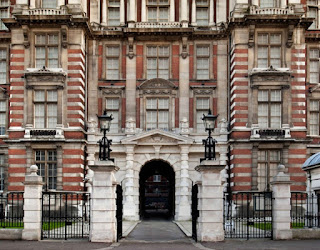 |
| Welcome sign at the entrance of the Royal Geographical Society. |
The Royal Geographic Society was the third place we visited for the British Studies Program. This visit was a little different from our previous ones, because a presentation was set up instead of a tour. The presentation consisted of not only the history behind the RGS, but it gave insight to some of their collections. On the table pictured below, one side had artifacts from the 'cold' regions and the opposite side had the 'hot' region artifacts. I really enjoyed this visit because the lecture revolved around these objects and the stories behind them!
 |
| After the lecture we were able to walk around and get a closer look at all the artifacts. |
The Royal Geographic Society was founded in 1830 to promote scientific geography, at a time where there was still unknow parts of the world. For instance, in 1819 Europeans had no knowledge of the interior of Africa, and places in South America and Antarctica entirely were still yet to be discovered by the Europeans. (Some of these places have been discovered, but the Europeans have not yet). The RGS wanted to collect and digest geographic information of the many unknown regions of the world. They even worked together with other societies of the world to accomplish this goal. They not only funded expeditions, but they also provided training, and lent out scientific instruments.
The RGS currently has a large collection of about 2 millions items. Of the 2 million items about half are maps, 1/2 million are various images like photographs, painting, drawing and glass plates. While about 250,000 are book volumes and their smallest part (and most interesting to see) of the collection are the artifacts. About half of their entire collection is digitized, leaving the rest accessible by card catalog.
|
|
The class viewing some of the artifacts on display. Pictured in the front is an incomplete map of Africa on the 'hot' side of the table.
|
The first part of the lecture was about the 'hot' expeditions. I found the stories to be very interesting, and the artifacts, maps and photographs that accompanied really brought them to life. The one that I enjoyed the most was about the discovery of the source of the Nile river. The source of the Nile was a real controversy, since a couple of different explorers claimed to find its source. The person first appointed by the RGS for the job was Richard Burton. Burton and his second in command John Speke set out in 1859. During this expedition, Speke set out on his own without Burton and found the source of the Nile to be Lake Victoria. This upset Burton, since Speke went without him and then took the credit for finding the source. So, Burton then venomously argued against Speke's findings, and claimed that the source was Lake Tanganyika. The controversy wasn't settled until around 1874 after Speke's death that it was discovered that he was correct.
 |
Portrait of Richard Burton.
Source: http://www.bbc.co.uk/history/historic_figures/burton_sir_richard.shtml
|
 |
Portrait of John Speke.
Source: https://www.npg.org.uk/
|
The second part of the lecture was about the 'cold' expeditions. The one that I found the most interesting were the stories about Mount Everest. Before the initial climbing of Mt. Everest there were a couple preliminary expeditions that occurred, because they first had to find the best route to get there. So, photographers were sent out to take photos of possible routes, and they were late scrutinized until they found the best pathway to the top. In 1922 George Finch (an Australian) went out, but only reached 27,400 feet (not to the top but still great). Then in 1924 Englishman George Mallory set out but disappeared. He was later discovered in 1999, his body was found 1000 feet from the top. It is still unknown if he ever made it to the top, if he did he would have been the first person to the top of Mt. Everest.
 |
Portrait of George Finch, Australian explorer.
Source: http://www.alpinist.com/doc/ALP45/24-tool-user-down-insulation
|
 |
Portrait of George Mallory.
Source: https://www.dailymail.co.uk/news/article-2240144/George-Mallory-died-climbing-Everest-His-Great-War-letters-reveal-life-lived.html
|
Overall, my visit to the Royal Geographic Society was really interesting. The presentation gave an excellent overview of the history behind the society, and I enjoyed learning about the intriguing stories behind their artifacts.
Source: Royal Geographic Society. (2019). https://www.rgs.org/



























